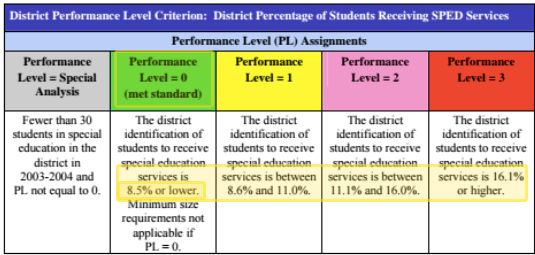The 74 Interview: Houston Chronicle Reporter on How He Uncovered the Year’s Biggest Education Scandal


Rosenthal: We found that in 2004, the Texas Education Agency arbitrarily decided what percentage of students should be in special education. That decision was made arbitrarily, and the benchmark was set far below both the state average at the time and the national average. The national average is about 13 percent of kids are in special ed; the state average at the time was 12 percent. Texas set its benchmark at 8.5 percent.
As a result, the percentage of kids in special ed in Texas has come down from that 12 percent down to exactly 8.5 percent. We’ve heard from hundreds of teachers and principals and administrators that the reason that percentage has come down is, schools saw that 8.5 percentage as a cap and they intentionally kept kids out of special education because of it, even if they personally felt that the child needed the services.
So Texas set a special education target — how did they enforce that target on districts? What were the carrots or sticks they used to get districts to comply?
In 2004, the Texas Education Agency rolled out a school district monitoring system, and the system was called the Performance Based Monitoring Analysis System (PBMAS). That system includes many indicators for judging school districts. Some of them include ones you’d think, like graduation rates, test scores, dropout rates, etc. But one of the indicators that was included in this system was special education rate. It said that the ideal — the quote it had was the “standard” — that the standard percentage should be 8.5 percent, and school districts that had special education enrollments of 8.5 percent or lower got a perfect score on that indicator.

If they were a little above 8.5 percent, essentially they didn’t get an A; they got a B. If they were way above that 8.5 percent, they got a C or a D. The way the system was set up, unless you were way off base in one indicator, you could not get in trouble for scoring poorly on one indicator in this system. But if you did poorly enough on enough of the indicators, you could be subject to a variety of sanctions, starting with audits and visits by state regulators, having to file corrective action plans, having to hire consultants, and even up to being taken over as a school district by the state.
It’s a little more complicated than simply saying if you were above 8.5 percent you were in trouble. But that’s why we talked to so many school employees who said they interpreted that policy and that indicator as saying they could not be above 8.5 percent and if they were, then they would be losing points and that could get them in a whole lot of trouble.
It’s pretty complicated in some ways, but in other ways, it’s not so complicated. The state said 8.5 percent is the ideal — and by the way, they said it was the ideal maximum. Under this system, you would get in trouble for getting at 8.6 percent and you would not get in trouble for being at 4 percent. You could, in theory, be giving special ed to 2 percent of your kids when the national average is 13 percent and you would be just fine on this system.
Even more so than the overall number, as troubling as the overall number was, this put in place a culture where schools were led to believe the more kids in special ed, the worse, almost no matter what. In talking to the hundreds and hundreds of educators, that really had an impact on how things worked in Texas for a long time.
How have the state and other policymakers and elected officials reacted to your reporting on this?
The state has denied that they have done anything wrong. They have said that this was not a cap. They have said that it was basically a misunderstanding, if anything, and that this was a policy that was intended to simply monitor school districts and potentially look for issues of disproportionality and overidentification. They say that they have no evidence that it actually led to this dramatic reduction in services. They believe the dramatic reduction in services is actually due to better teaching techniques that have reduced the number of kids who need special education services. They have completely denied any wrongdoing.
However, the federal government is concerned about this. They have been investigating. I know a lot of lawmakers in the state and a lot of advocates and experts are really skeptical of the state’s explanation. They point out, for example, that there is nothing that Texas is doing in terms of teaching techniques that is any different than any other state in the country, and yet no other state has seen this dramatic reduction. The state’s explanation really doesn’t make any sense. Again, we’ve heard from hundreds of current and former school employees who admit to denying services. I think that what’s happening is the state is trying to avoid responsibility, but some other people are trying to ensure that they take responsibility.
I left out the most important part, though: the state has agreed to end this policy.
This is the 10th bill filed so far in response to our series on the denial of special ed services in Texas (https://t.co/btz0Z4TqJ5) #txlege
— Brian M. Rosenthal (@brianmrosenthal) March 1, 2017
So they deny it exists, but they're ending it?
Correct. Well, they deny that it was ever a cap. What they say is that it was a monitoring system, that it was, if anything, a goal.
Certainly now they have suspended its use. No districts are now being punished for having special ed enrollments of above 8.5 percent. They say that soon they will be permanently eliminating it.
Your reporting had real clear results in that respect, and that’s always nice.
Yeah — it is nice. It’s still ongoing as well. The federal government is still conducting this investigation. Actually, several different school districts, including the two biggest school districts in the state — Houston and Dallas — are both hiring third-party auditors to come in and review their special ed departments.
I think maybe most importantly, there’s a real discussion going on about how to serve kids with disabilities and why Texas has such a low percentage of kids in special ed, because that’s the other thing I didn’t mention in my 30-second review: The 8.5 percent of kids in special ed, where Texas is at now, is the lowest in the country by far. No other state is anywhere close to that. I think the state is really grappling with that, which I think is an important conversation, so it’s gratifying to see it happening.
Why do you think it took so long for this to come out? As you said, this target went into place in 2004 — many people must have known about it.
That’s honestly one of the biggest mysteries of this whole thing. Part of the answer is that the state education agency did not publicly announce this policy. It wasn’t the result of legislation or an order from the federal government or from the state Board of Education. In fact, none of these entities even knew about this. That’s part of the reason.
Obviously, school districts did know about it. It was communicated to school districts — not necessarily to rank-and-file teachers but to special education directors — so the question becomes, why did they not say something about this? I think the answer is a couple things.
First of all, in talking with people who knew about this cap, they believed that it was put in place by the federal government. They also believed that it was “research based” — that some research had determined that 8.5 percent was the ideal number, when in fact it hadn’t. It was completely arbitrary.
I’m not an education reporter; I’m an investigative reporter who happened to look into this. I think from what I’ve learned about the education system over the past year, it’s a real example of how many regulations there are in schools and how schools are so compliance-focused that they, especially in special education, comply with what they think the rules are and they’re not given a lot of room to think about whether it’s actually in the best interests of kids.
I think part of it is because there are so many layers of authority in education. There’s your principal, there’s the superintendent, there’s the state, there’s the federal government, and each layer of authority can always blame the next layer. And that sounds like what happened here.
Absolutely. I have not found really anybody who has owned up to this in any significant way. We have now talked to almost 200 teachers and administrators who admit to denying services to kids who needed them because of this, but all of them say they were forced to do it and they felt bad about it. I’m sure that’s true. I don’t think anybody gets into education to hurt kids.
I continue to receive emails like this every day from educators in Houston & elsewhere in Texas. Shocking and sad. #txlege #txed #specialed pic.twitter.com/ci8eSBU2ja
— Brian M. Rosenthal (@brianmrosenthal) January 27, 2017
What was the rationale of the policy from on high, from the Texas Education Agency? Was it about saving money?
It’s hard to know what the rationale was, in part because it was 12 years ago and, because it was not publicly announced, there was no public debate over it. If there had been, that would have been great, both in terms of engaging the public but also in terms of reporting about it. Any documents that were created at that time are hard to come by these days. It’s hard to know.
What I can tell you is I have talked to numerous former Texas Education Agency employees who say that this was a cost-saving move. The fact is that when this policy was put in place in 2004, the agency was dealing with a significant state budget cut — a $1.1 billion state budget cut. We’ve heard from several former employees who say this was a response to that.
Just to be fair to the state, they have denied that. In fact, one of their most forceful denials is on that point, about whether it was financially motivated. They say that this monitoring and this indicator, as they call it, was put in place due to concerns about overidentification and about disproportionality in special education, which is the idea that some minorities, specifically African Americans, are put into special education more than white students and there is concern about whether that is harming them.
Texas, like you said, has the lowest rate of special education identification. So the only argument in favor of their policy I could think of is that all other states are overidentifying students. Perhaps some would argue special education services are overused and not particularly effective. Do you think there’s any validity to that?
I think you’re right in thinking about that. I remember very vividly my conversation with the superintendent of Houston Independent School District, which is the biggest school district in the state, and this particular superintendent just started in September, and he previously was the superintendent in San Francisco, which has a much higher special education rate. I think it’s at around 12 percent. He was defending Houston’s rate, which is actually lower than the state average and is at 7.4 percent. I said, “If you’re defending the 7.4 percent, does that mean that you thought that almost half of your students in special ed in San Francisco should not have been in special ed?” He did not really have an answer for that, frankly.
I think that is a good way to look at it, but the answer is, I don’t really know. As I said, I don’t consider myself an education expert. I’m going off of what I’ve heard from people. What the people in Texas say is that students are significantly underidentified in Texas: There are many students who should be receiving special ed in Texas who are not.
Can you tell me a little bit about the reporting process? How did you first get the idea for this story? When did you start reporting it? How long did it take to report out and write the whole series?
I started the work on it in early March of 2016, and it started, as with most stories that we do, from a tip. This tip was from an advocate — his name is Dustin Rynders, and he’s the education director at Disability Rights Texas, a federally funded advocacy group.
Disability Rights had discovered this policy, I believe, a year or a year and a half previous to my conversation with Dustin. They had stumbled across it years after it had been put in place, and they were concerned about it. They had actually complained to the Texas Education Agency and to the U.S. Department of Education. Those complaints were ignored. The state, in fact, told Dustin that they would not even look into this unless Dustin could prove that an individual student had been turned away due to this 8.5 percent, which basically would have meant Dustin would have had to produce an email from the special education director to a teacher saying don’t put Johnny in special education because we’re over the cap. That’s a very high standard of proof, and Dustin was not able to do that.
I happened to talk with him, and he was looking for somebody to write about this, so we took it on and we were intentionally exhaustive in our approach. I’ve done a lot of stories — none of them involved nearly as much work as this. The tip was that the state is systematically, secretly, and illegally harming tens of thousands of kids. It’s not a tip that you get every day, certainly not from a respected advocacy group like Disability Rights Texas. We had to take this extremely seriously.
I actually just looked at the numbers, and I have a list. We ended up interviewing more than 1,000 people about this, including 323 current and former school employees; 391 parents; 118 advocates; 112 education experts, including special education experts in Texas and around the country; and almost 50 former Texas Education Agency employees.
The first question, by the way, to everybody we talked to — we presented them with a fact, and the fact is that there has been a massive reduction in kids in special education in Texas. A 32 percent reduction, from 12 percent down to 8.5 percent. A reduction that is unprecedented, that no other state has seen in the history of special education. We said to these 1,000 people, “What is your explanation for that? Why do you think that happened?”
The only answer we got was this cap.
Well, it’s not the only answer we got — it’s the only legitimate answer we got. The other speculation we got, we looked into. We did get more than a dozen other theories, and we looked into it. We requested mounds and mounds of data. I think I also just did the calculation on this, and we filed more than 300 public records requests for data and documents.
We were purposefully exhaustive in talking to people. The story was driven by the experiences from people on the ground, including parents and advocates, but also educators. It was also driven by data, of course. There’s a huge data component to this. We posted all of our data online.
In answer to your question, it was a very long way of saying, it took about six months for our first story, which was kind of an overview story.
Was that most or all of what you worked on for those six months?
Yes.
In the beginning, I had a few other stories that I was doing that I was finishing up, but for the majority of that, yeah, that was what I did every day, 24/7 basically.
We put out the first story in September. We had every intention of doing several more stories. We wanted to get the first story out, frankly, to help us tap into the community because we knew there were so many people affected by this, and we wanted to be able to reach them, so we created a community; we put up a form for people to contact us. Hundreds and hundreds of people contacted us, and we ended up doing six more stories about this, and it took us through the end of the year. In all, the seven-part series took 10 months to do.
How big a team did you work with on this? Were there other reporters you worked with on this?
Interestingly, for the majority of this, it was just me and an extremely talented photographer that we have, named Marie DeJesus. It was me and her for a long time. Toward the end of the project, we did get some support with the reporting, in part because we were getting so many responses from parents and we wanted to respond to them. Two other reporters helped at the end, and that would be St. John Barned-Smith and Susan Carroll. It was basically the four of us in addition to two Web people, Jordan Rubio and Rachael Gleason, and our editor, Vernon Loeb. That was the team, so seven people in all.
Why do you think some school districts really complied aggressively with the 8.5 percent target and even went below that, whereas other school districts were less responsive and didn’t cut special education rates much at all?
It’s a very good question. The numbers that we have show that 96 percent of school districts have cut special education rates in Texas since 2004. But many cut very deeply and many did not cut that deeply. There are still many school districts in Texas that are above the 8.5 percent.
It just varied — it’s kind of a fascinating experiment of if you’re told to get down to 8.5 percent. It’s not something you can do overnight. You’re at 12 percent one day, so unless you’re just going to have a massive purge where you remove a third of your kids — which, by the way, some school districts did, but very few did, and it would have attracted a lot of attention and would have been extremely illegal and very problematic.
I think what school districts are more likely to do is change their policies especially around admitting into special education, and as the 12th-graders phase out, there are fewer kindergartners, and when the kindergarten class comes in, they’re at a lower percentage, so it kind of happens gradually. There’s a reason why it took over 10 years for the state to accomplish its goal of getting down to 8.5 percent, because it’s a difficult thing to do.
I think they thought they had to, so they adjusted their culture and policies and practices to move in that direction. Because there were different ways that played out in different districts, the numbers were affected in different ways.
I know Texas has a pretty large charter school sector. To what extent were charter schools a part of this?
Charter schools were certainly a part of this, and they were also subject to the 8.5 percent target. For this monitoring system, in which the 8.5 percent standard was included, the system judges school districts, and for the purposes of the system, each charter school was considered to be its own school district. In a way it was even harder on charter schools, whereas a district, if they had 10 schools, some of those schools could have a higher percentage, some could have a lower percentage, and they would fall at around 8.5 percent. Charter schools really had to be right at it in every school.
There were also some other issues around charter schools and special education identification. I think there has been a lot of coverage around charter schools not doing what they should to provide special education services to all the kids who need it. I think there’s a lot more at play, frankly, with those schools. We did look at those numbers, and the numbers show that for charter schools, the special education rate is significantly less than for traditional public schools.
The percentage of kids for charter schools in Texas today who are in special education is 6.5 percent. Again, the state average is 8.5 percent, and the average in traditional schools is around 8.6 or 8.7 percent because the vast majority of students are in those schools.
How have special education advocates in Texas reacted to the nomination and confirmation of Betsy DeVos as education secretary?
Not well.
I think there’s a lot of fear, especially because the federal government right now is investigating Texas. Despite the fact that hundreds of current and former school employees have admitted to denying services to kids with disabilities because of this policy, the Texas Education Agency is still denying any wrongdoing, and I think there’s a lot of fear among special education advocates that the state is going to get away with this.
The fact that the federal government is investigating is very encouraging to advocates, so they’re afraid that DeVos — who showed in her confirmation hearing that her knowledge of the federal special education law is not where some people believe it should be — there’s fear that she will not be aggressive in going after Texas.
In general, special education advocates are worried — not just about this, but they are worried about whether they will have a strong advocate in Washington, D.C., for the right of all kids with disabilities to get a free and appropriate education. There is certainly room for DeVos to prove them wrong. I know she wrote a letter saying that she will be standing up for those “hard-won” rights, as she said, but without a doubt, in talking to advocates, there is some concern.
Get stories like these delivered straight to your inbox. Sign up for The 74 Newsletter

;)
